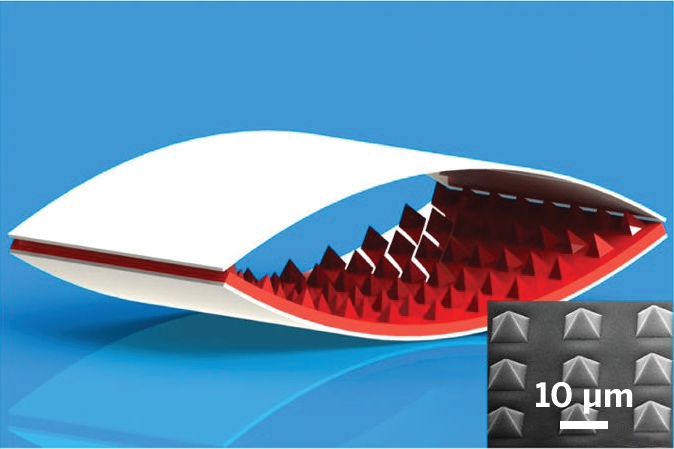

This implantable power generator uses the body’s motion to power an infrared laser that could promote bone healing. Inside the generator, pyramid-shaped structures 5 μm across at their base increase the device’s surface area, which improves its power output. Credit: ACS Nano
Medical implants and wearable devices that harvest energy from the bearer’s movements and convert it into electrical power could help patients avoid the inconvenience of replacing batteries and the risk of follow-up surgeries to replace them. Zhong Lin Wang, a materials scientist at Georgia Tech in Atlanta and the Chinese Academy of Sciences in Beijing, has already shown his group’s energy-scavenging device can power a pacemaker (Adv. Mater. 2010, DOI: 10.1002/adma.200904355). Now he and his Beijing team have shown that they can also power a laser for accelerating bone-healing (ACS Nano 2015, DOI: 10.1021/acsnano.5b03567).
Wang’s power converting devices rely on static electricity. They sandwich two flexible films with oppositely charged surfaces—one of polydimethylsiloxane and the other of indium tin oxide—connected to one another in an electrical circuit. With the bend of an elbow or the rise and fall of the chest, the films are squished, changing the voltage between them and driving a current in the circuit that can power lasers, LEDs, or other devices.
Biologists have shown that low-intensity light from infrared lasers can encourage the growth of early-stage bone cells, a key part of bone healing. Wang wondered if his team could make a simple, self-powered device to carry out this kind of light therapy. In vitro tests showed that an implantable-generator-powered infrared laser accelerated the proliferation of early-stage mouse bone cells by 15 percent after two days compared with untreated cells. They also showed that, when implanted in mice in between the diaphragm and the liver, the generator produced power from the diaphragm’s motion—but they still need to test bone healing in the mouse.
The device converts about 50% of mechanical energy into electrical energy—good enough for proof-of-concept medical devices, says Wang, but practical systems will require higher conversion rates. Next they’ll work on boosting the generator’s power output: When the device was attached to a person’s skin at the elbow to test its output under human motion, the laser fired only once per minute. “We want to continue improving the power output so that we can speed up wound healing,” he says. (Chemical & Engineering News)

86-10-68597521 (day)
86-10-68597289 (night)

52 Sanlihe Rd., Xicheng District,
Beijing, China (100864)

